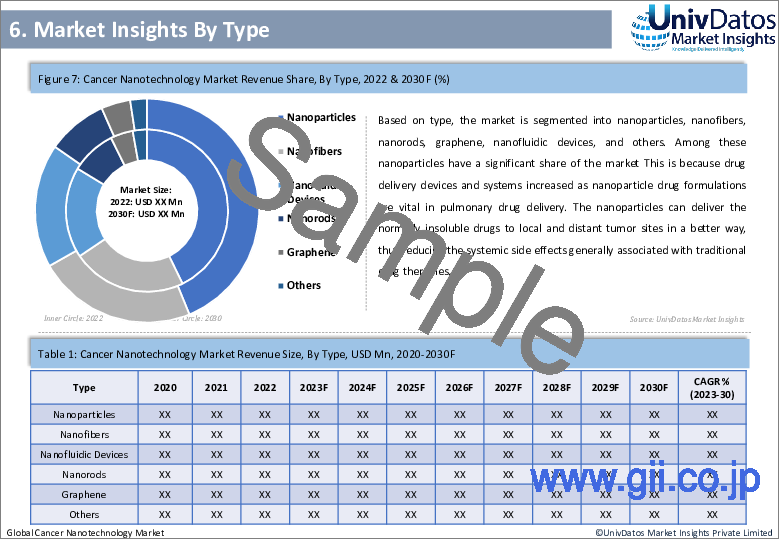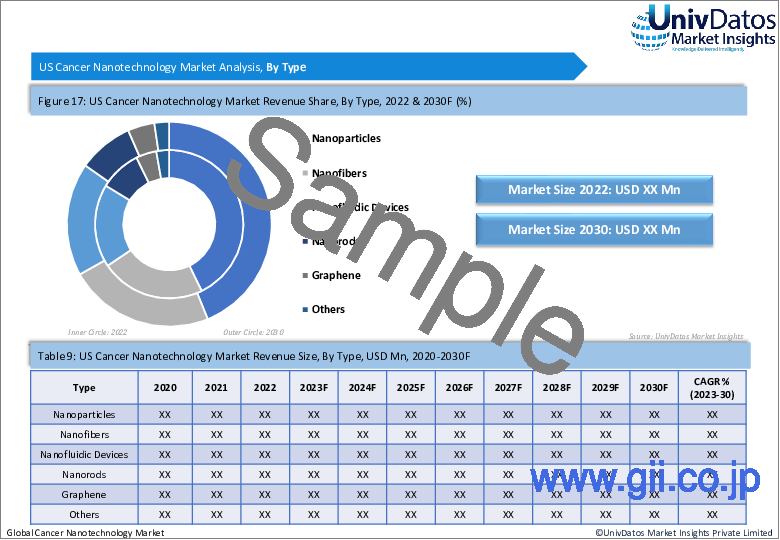|
|
市場調査レポート
商品コード
1346736
がんナノテクノロジー市場:現状分析と予測(2023-2030年)Cancer Nanotechnology Market: Current Analysis and Forecast (2023-2030) |
||||||
カスタマイズ可能
|
|||||||
| がんナノテクノロジー市場:現状分析と予測(2023-2030年) |
|
出版日: 2023年08月01日
発行: UnivDatos Market Insights Pvt Ltd
ページ情報: 英文 145 Pages
納期: 即日から翌営業日
|
- 全表示
- 概要
- 目次
がんナノテクノロジー市場は、2023年から2030年にかけて約13.8%のCAGRを記録すると予測されています。ナノテクノロジーは、がん細胞や新生物を直接かつ選択的に治療対象とする手段を提供します。これらのツールを使えば、臨床医は化学療法、放射線療法、次世代の免疫・遺伝子療法を安全かつ効果的に腫瘍に送り込むことができます。例えば、GLOBOCAN, 2020によると、2020年の世界のがん罹患者数は1,930万人、がん死亡者数は1,000万人に増加しています。このようながんの有病率の増加は、がんナノテクノロジー市場の成長に寄与しています。さらに、がん治療の改善や希少疾患への対応を目的とした政府の取り組みや政策が市場の成長に寄与しています。2018年、科学技術省の科学者たちは、内在するリガンド(イオンや分子)を利用することなく腫瘍細胞の核に抗がん剤を送達する汎用性の高いビークルとして、生体適合性の高い多孔性ポリジメチルシロキサン(PDMS)ナノ粒子を作製しました。細胞の核には遺伝物質のほとんどが含まれています。体内の因子や処置に反応して特性を変化させる生物活性化ナノ粒子は、生体内状態の動的レポーターとして機能し、疾患の進行や治療反応に関する空間的・時間的情報を提供することができます。したがって、がんナノテクノロジー市場の成長を後押しします。
市場はタイプ別に、ナノ粒子、ナノファイバー、ナノロッド、グラフェン、ナノ流体デバイス、その他に区分されます。このうちナノ粒子が市場で大きなシェアを占めています。これは、ナノ粒子製剤として増加したドラッグデリバリーデバイスやシステムが、肺へのドラッグデリバリーに不可欠だからです。ナノ粒子は、通常不溶性の薬剤をより良い方法で局所および遠隔の腫瘍部位に送達することができるため、従来の薬物療法に一般的に関連する全身性の副作用を軽減することができます。
用途別に見ると、市場は診断薬、治療薬、セラノスティクスに区分されます。このうち、診断薬は2022年の市場シェアが高く、予測期間中も支配的であろう。これは、医療診断とイメージングにおけるナノテクノロジー採用の増加が市場成長需要を高めているためです。生物医学研究では、ナノテクノロジーはCOVID-19に対して広く使用されています。特定の薬の有効成分のカプセル化に基づく治療としてナノ粒子を使用する数多くの予防接種のように。数多くのナノシステムが、従来のものよりも治療目的の候補として優れていることが判明しています。したがって、この要因が市場の成長を後押ししています。
がんの種類によって、市場は乳がん、胃がん、肺がん、その他に区分されます。このうち、乳がんは予測期間中に高い市場シェアを獲得すると思われます。乳がんは、乳がん管理のための幅広いナノテクノロジーの存在と乳がん有病率の急増により、市場で60%以上のシェアを占めています。
ナノ医薬品の市場導入に関するより良い理解のために、市場は北米(米国、カナダ、その他北米地域)、欧州(ドイツ、フランス、イタリア、スペイン、英国、その他欧州地域)、アジア太平洋地域(中国、日本、インド、その他APACのその他諸国)、世界の国々における世界の存在に基づいて分析されています。がんナノテクノロジーは様々な要因から北米で人気が高まっています。北米のがんナノテクノロジー市場は、がんの有病率の増加、ヘルスケア専門家や一般住民のナノテクノロジーに対する意識の高まり、高度なイメージング技術の開拓、治療選択肢の増加などを背景に、今後も成長を続けると予測されています。例えば、Cancer.netによると、2020年には推定586,202人が甲状腺がんと診断されました。
ジョンソン・エンド・ジョンソン、GEヘルスケア、Combimatrix Corporation(Invitae Corporation)、F. Hoffmann-La Roche、Sigma-Tau Pharmaceuticals Inc.、Merck and Company Inc.、Pfizer, Inc.、Nanosphere, Inc.いくつかのM&Aや提携も行われています。
目次
第1章 市場イントロダクション
- 市場の定義
- 主な目標
- ステークホルダー
- 制限事項
第2章 調査手法または前提
- 調査プロセス
- 調査手法
- 回答者プロファイル
第3章 市場要約
第4章 エグゼクティブサマリー
第5章 COVID-19ががんナノテクノロジー市場に与える影響
第6章 がんナノテクノロジー市場収益 、2020-2030年
第7章 タイプ別の市場洞察
- ナノ粒子
- ナノファイバー
- ナノロッド
- グラフェン
- ナノ流体デバイス
- その他
第8章 アプリケーション別の市場洞察
- 診断
- 治療学
- セラノスティクス
第9章 アプリケーション別の市場洞察
- 乳がん
- 胃がん
- 肺がん
- その他
第10章 地域別の市場洞察
- 北米
- 米国
- カナダ
- その他北米地域
- 欧州
- ドイツ
- 英国
- フランス
- イタリア
- スペイン
- その他欧州地域
- アジア太平洋
- 中国
- 日本
- インド
- 韓国
- APACのその他諸国
- 世界のその他の地域
第11章 がんナノテクノロジー市場力学
- 市場促進要因
- 市場の課題
- 影響分析
第12章 がんナノテクノロジー市場機会
第13章 がんナノテクノロジー市場動向
第14章 需要側と供給側の分析
- 需要側分析
- 供給側分析
第15章 バリューチェーン分析
第16章 価格分析
第17章 競合シナリオ
- 競合情勢
- ポーターのファイブフォース分析
第18章 企業プロファイル
- Abbott
- GE Healthcare
- Combimatrix Corporation(Invitae Corporation)
- Mallinckrodt Plc
- Sigma-Tau Pharmaceuticals Inc.
- Merck and Company Inc.
- Pfizer, Inc.
- Nanosphere, Inc.(Luminex Corporation)
- Celgene Corporation
- Teva Pharmaceutical Industries
第19章 免責事項
The cancer nanotechnology market is expected to register a CAGR of approx. 13.8% over the period of 2023-2030. Nanotechnology offers the means to target therapies directly and selectively for cancerous cells and neoplasms. With these tools, clinicians can safely and effectively deliver chemotherapy, radiotherapy, and the next generation of immuno- and gene therapies to the tumor. For instance, according to GLOBOCAN, 2020, the global cancer burden increased to 19.3 million cases and 10 million cancer deaths in 2020. This increasing prevalence of cancer contributes to the growth of the cancer nanotechnology market. Furthermore, government initiatives and policies aimed at improving cancer care and addressing rare diseases have contributed to the growth of the market. In 2018, Scientists at the Department of Science and Technology fabricated highly biocompatible porous polydimethylsiloxane (PDMS) nanoparticles as a versatile vehicle to deliver anti-cancer drugs to the nuclei of tumor cells without utilizing any intrinsic ligands (ions or molecules). The nucleus of any cell contains most of its genetic material. Bioactivatable nanoparticles that modify properties in reaction to factors or procedures within the body act as dynamic reporters of in vivo states and can provide both spatial and temporal information on disease progression and therapeutic response. Hence, boost the growth of cancer nanotechnology market.
Based on type, the market is segmented into nanoparticles, nanofibers, nanorods, graphene, nanofluidic devices, and others. Among these nanoparticles have a significant share of the market. This is because drug delivery devices and systems increased as nanoparticle drug formulations are vital in pulmonary drug delivery. The nanoparticles can deliver the normally insoluble drugs to local and distant tumor sites in a better way, thus reducing the systemic side effects generally associated with traditional drug therapies.
Based on application, the market is segmented into diagnostics, therapeutics, and theranostics. Among these, diagnostics has a high market share in 2022 and will dominate during the forecast period. This is due to the rise in the adoption of nanotechnology in medical diagnosis and imaging is increasing the market growth demand. In biomedical research, nanotechnology is widely used against COVID-19, as in numerous vaccinations that use nanoparticles as a treatment based on the encapsulation of the active ingredient of certain medications. Numerous nanosystems have been found to be better candidates for therapeutic purposes than conventional ones. Thus, this factor boosts market growth.
Based on the cancer type, the market is segmented into breast cancer, stomach cancer, lung cancer, and others. Among this breast cancer will attain a high market share during the forecast period. Breast cancer held more than 60% share in the market owing to the presence of wide range of nanotechnology for the management of breast cancer and the surge in the prevalence of breast cancer.
For a better understanding of the market adoption of nanomedicines, the market is analyzed based on its worldwide presence in the countries such as North America (U.S., Canada, and Rest of North America), Europe (Germany, France, Italy, Spain, U.K., and Rest of Europe), Asia-Pacific (China, Japan, India, and Rest of APAC), and Rest of World. Cancer Nanotechnology has gained increasing popularity in North America due to various factors. The North America Cancer Nanotechnology market is expected to continue to grow in the coming years, driven by the increasing prevalence of cancer and growing awareness of nanotechnology among healthcare professionals and the general population, development of advanced imaging techniques and the rise in treatment option. For instance, in 2020, according to Cancer.net, an estimated 586,202 people were diagnosed with thyroid cancer.
Some of the major players operating Johnson & Johnson, GE Healthcare, Combimatrix Corporation (Invitae Corporation), F. Hoffmann-La Roche, Sigma-Tau Pharmaceuticals Inc., Merck and Company Inc., Pfizer, Inc., Nanosphere, Inc. (Luminex Corporation), Celgene Corporation, and Teva Pharmaceutical Industries among others. Several M&A's along with partnerships have been undertaken.
TABLE OF CONTENTS
1 MARKET INTRODUCTION
- 1.1. Market Definitions
- 1.2. Main Objective
- 1.3. Stakeholders
- 1.4. Limitation
2 RESEARCH METHODOLOGY OR ASSUMPTION
- 2.1. Research Process of the CANCER NANOTECHNOLOGY Market
- 2.2. Research Methodology of the CANCER NANOTECHNOLOGY Market
- 2.3. Respondent Profile
3 MARKET SYNOPSIS
4 EXECUTIVE SUMMARY
5 IMPACT OF COVID-19 ON THE CANCER NANOTECHNOLOGY MARKET
6 CANCER NANOTECHNOLOGY MARKET REVENUE (USD Mn), 2020-2030F
7 MARKET INSIGHTS BY TYPE
- 7.1. Nanoparticles
- 7.2. Nanofibers
- 7.3. Nanorods
- 7.4. Graphene
- 7.5. Nanofluidic Devices
- 7.6. Others
8 MARKET INSIGHTS BY APPLICATION
- 8.1. Diagnostics
- 8.2. Therapeutics
- 8.3. Theranostics
9 MARKET INSIGHTS BY APPLICATION
- 9.1. Breast Cancer
- 9.2. Stomach Cancer
- 9.3. Lung Cancer
- 9.4. Others
10 MARKET INSIGHTS BY REGION
- 10.1. North America
- 10.1.1. U.S.
- 10.1.2. Canada
- 10.1.3. Rest of North America
- 10.2. Europe
- 10.2.1. Germany
- 10.2.2. UK
- 10.2.3. France
- 10.2.4. Italy
- 10.2.5. Spain
- 10.2.6. Rest of Europe
- 9.3. Asia-Pacific
- 10.3.1. China
- 10.3.2. Japan
- 10.3.3. India
- 10.3.4. South Korea
- 10.3.5. Rest of APAC
- 10.4. Rest of the World
11 CANCER NANOTECHNOLOGY MARKET DYNAMICS
- 11.1. Market Drivers
- 11.2. Market Challenges
- 11.1. Impact Analysis
12 CANCER NANOTECHNOLOGY MARKET OPPORTUNITIES
13 CANCER NANOTECHNOLOGY MARKET TRENDS
14 DEMAND AND SUPPLY-SIDE ANALYSIS
- 14.1. Demand Side Analysis
- 14.2. Supply Side Analysis
15 VALUE CHAIN ANALYSIS
16 PRICE ANALYSIS
17 COMPETITIVE SCENARIO
- 17.1. Competitive Landscape
- 17.1.1. Porters Fiver Forces Analysis
18 COMPANY PROFILED
- 18.1. Abbott
- 18.2. GE Healthcare
- 18.3. Combimatrix Corporation (Invitae Corporation)
- 18.4. Mallinckrodt Plc
- 18.5. Sigma-Tau Pharmaceuticals Inc.
- 18.6. Merck and Company Inc.
- 18.7. Pfizer, Inc.
- 18.8. Nanosphere, Inc. (Luminex Corporation)
- 18.9. Celgene Corporation
- 18.10. Teva Pharmaceutical Industries





